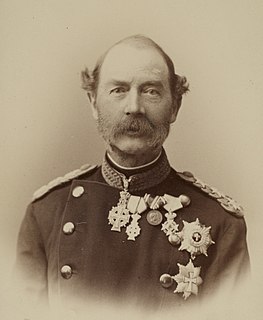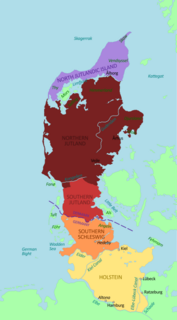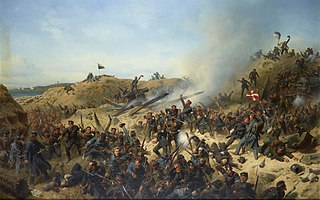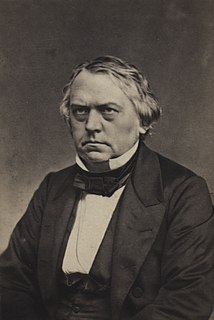
Christian X was King of Denmark from 1912 to 1947, and the only King of Iceland in the form of a personal union rather than a real union between 1918 and 1944.

Christian IX was King of Denmark from 1863 until his death in 1906. From 1863 to 1864, he was concurrently Duke of Schleswig, Holstein and Lauenburg.

Frederick VII was King of Denmark from 1848 to 1863. He was the last Danish monarch of the older Royal branch of the House of Oldenburg and the last king of Denmark to rule as an absolute monarch. During his reign, he signed a constitution that established a Danish parliament and made the country a constitutional monarchy. Frederick's motto was Folkets Kærlighed, min Styrke .

The history of Schleswig-Holstein consists of the corpus of facts since the pre-history times until the modern establishing of the Schleswig-Holstein state.

Thorvald August Marinus Stauning was the first social democratic Prime Minister of Denmark. He served as Prime Minister from 1924 to 1926 and again from 1929 until his death in 1942.

The Second Schleswig War also sometimes known as the Dano-Prussian War or Prusso-Danish War was the second military conflict over the Schleswig-Holstein Question of the nineteenth century. The war began on 1 February 1864, when Prussian and Austrian forces crossed the border into Schleswig. Denmark fought the Kingdom of Prussia and the Austrian Empire. Like the First Schleswig War (1848–1852), it was fought for control of the duchies of Schleswig, Holstein and Lauenburg, due to the succession disputes concerning them when the Danish king died without an heir acceptable to the German Confederation. The war started after the passing of the November Constitution of 1863, which integrated the Duchy of Schleswig into the Danish kingdom in violation of the London Protocol.

Niels Thomasius Neergaard was a Danish historian and political figure, a member of the Liberal Moderate Venstre and since 1910 of Venstre. He served as Council President of Denmark between 1908 and 1909 as head of the Cabinet of Neergaard I and as both Prime minister of Denmark and Finance Minister from 5 May 1920 to 23 April 1924, leading the Cabinet of Neergaard II and III. His last cabinet office was as Finance Minister.

Peter Martin Orla Lehmann was a Danish statesman, a key figure in the development of Denmark's parliamentary government.

Ditlev Gothard Monrad was a Danish politician and bishop, and a founding father of Danish constitutional democracy; he also led the country as Council President in its huge defeat during the Second Schleswig War. Later, he became a New Zealand pioneer before returning to Denmark to become a bishop and politician once more.

After the 1901 Danish Folketing election, the Council President Johan Henrik Deuntzer of the Venstre Reform Party became the leader of Denmark's first liberal government. The resulting cabinet, which replaced the Cabinet of Sehested consisting of members of the conservative party Højre, was formed on 24 July 1901 and was called the Cabinet of Deuntzer. The formation of the new cabinet is referred to in Danish as "systemskiftet", the shift of government.

Minister for Iceland was a post in the Danish cabinet for Icelandic affairs.

The Cabinet of Moltke II was the government of Denmark from 16 November 1848 to 13 July 1851. It was also referred to as the November Cabinet.
Kjeld Løwenstein Philip was a Danish economist and politician representing the Danish Social Liberal Party. He was Trade Minister from 1957 to 1960 as member of the Cabinet of H. C. Hansen II and the Cabinet of Viggo Kampmann I, Finance Minister from 1960 to 1961 as member of the Cabinets of Viggo Kampmann I and II and Minister for the Economy from 1961 to 1964 as member of the Cabinet of Viggo Kampmann II and the Cabinet of Jens Otto Krag I. He was member of the Danish parliament from 1960 to 1964. His wife, Grethe Philip (1916–2016) was a member of parliament 1960–1979.
The Society of the Friends of Peasants was a liberal Danish political society founded on 5 May 1846 by members of the provincial consultative assemblies Johan Christian Drewsen and Balthazar Christensen, with the intent to promote the liberation of the peasantry and equality among the different classes of society. Among its most politically influential members were Anton Frederik Tscherning, Jens Andersen Hansen and Carl Christian Alberti.

Henrik Nicolai Clausen was a Danish theologian and national liberal statesman.

Andreas Frederik Krieger was a Danish politician, government minister, professor of law and supreme court judge. He was a member of the National Constitutional Assembly from 1848 to 1849, a member of the Folketing from 1849 to 1852 representing the National Liberal Party and a member of the Landsting from 1863 to 1890 representing first the National Liberal Party and later the conservative party Højre.

Ant(h)on Frederik Tscherning was a Danish army officer who became a politician.

Frederik Georg Julius Moltke, Count of Bregentved, was a Danish landowner and politician.

The March Revolution in Denmark refers to the events of 1848 that ultimately led to the introduction of Danish constitutional monarchy and the Constitution of Denmark.

















